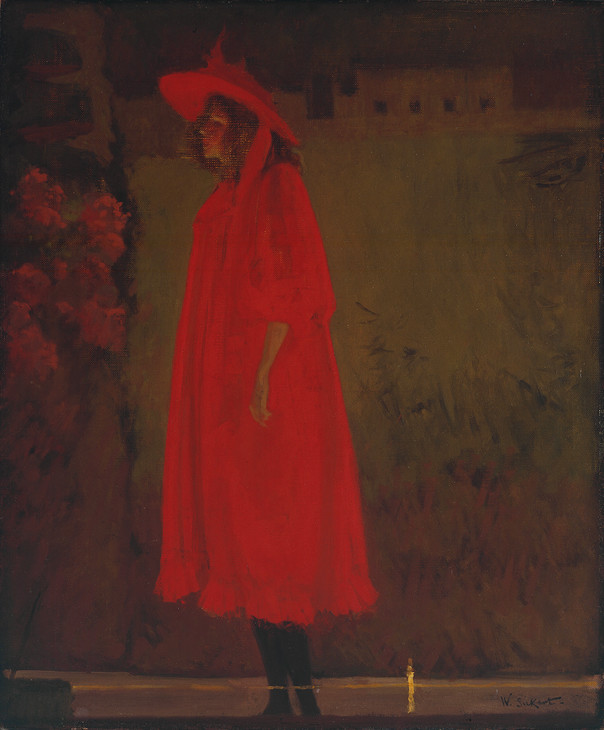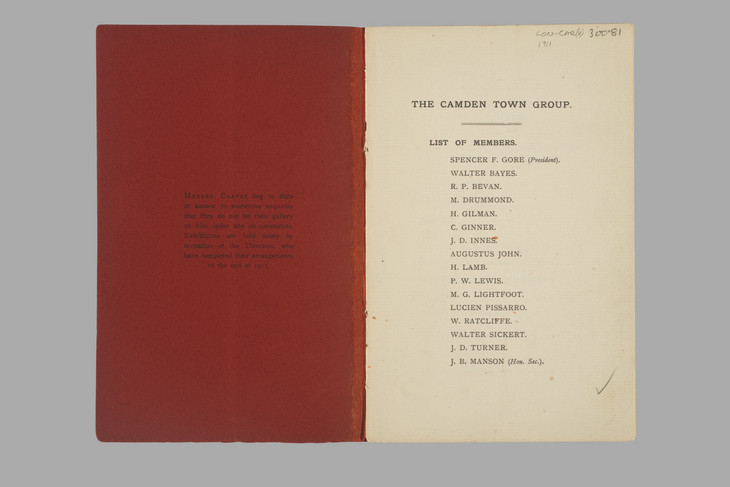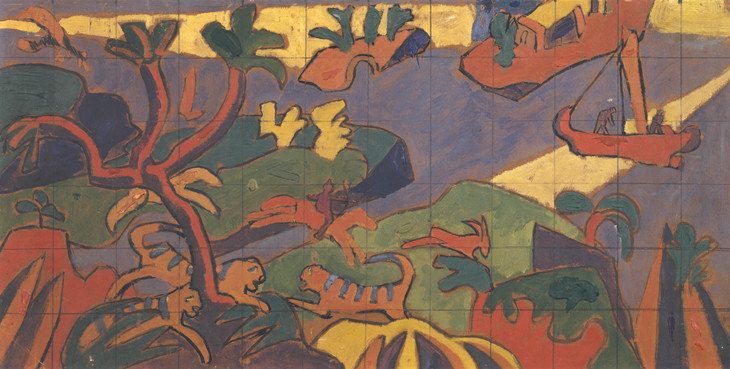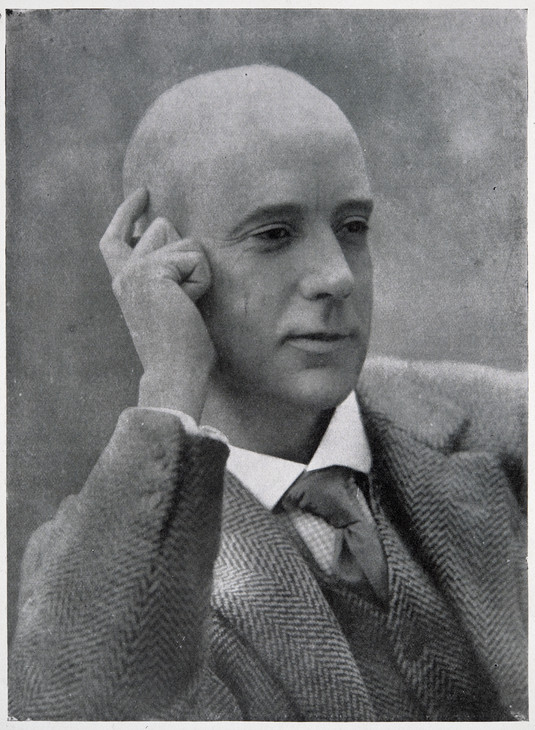Chronology
1900
Robert Bevan and Stanislawa de Karlowska settle at 14 Adamson Road in the Swiss Cottage area of London.
Albert Rutherston contributes two pictures to the New English Art Club and meets Walter Sickert on a painting holiday in Dieppe, France, where the latter has lived intermittently in self-imposed exile from London since 1898.
1901
Harold Gilman completes his studies at the Slade School of Fine Art, where his contemporaries include Spencer Gore, Augustus John, Wyndham Lewis, William Orpen and Albert Rutherston.
Maxwell Gordon Lightfoot begins his art training at Chester Art School.
1902
Spencer Gore and Wyndham Lewis visit Madrid together. Harold Gilman also travels there to see paintings by Velázquez and Goya at the Prado museum.
Walter Sickert begins making drawings of nudes on iron bedsteads in Neuville.
1903
Malcolm Drummond enrols at the Slade School of Fine Art.
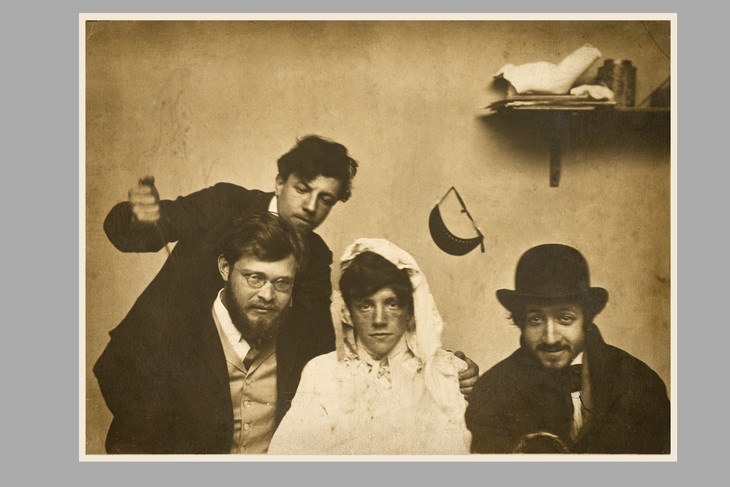
Charles Polowetski, Bernard Gussow, James Bolivar Manson and Samuel Halpert in a Studio on Rue Belloni, Paris 7 June 1903
Photograph, black and white, on paper, taken by Charles Ezekiel Polowetski (born 1884)
Inscribed in an unknown hand 'Halpert did a Beardsley portrait of [?"him" or "me"]', 'In Jacob Epstein's Studio | rue Belloni, Paris', 'Charles | Polowetski', 'June 7 1903', 'Bernard | Gussow', 'J B Manson', 'Samuel Halpert' and annotations for printing in pencil on back
Tate Archive TGA 792/17
Charles Polowetski, Bernard Gussow, James Bolivar Manson and Samuel Halpert in a Studio on Rue Belloni, Paris 7 June 1903
Tate Archive TGA 792/17
Leeds Arts Club is founded by schoolteacher Alfred Orage and Yorkshire textile manufacturer Holbrook Jackson. Charles Ginner will deliver a lecture there in 1915.
This seems like it only relates to Ginner’s later work, but since the trip to Leeds to see Frank Rutter is also included (1913) I suppose this makes enough sense here...
The first Salon d’Automne is held in Paris, showing post-impressionist and other avant-garde artists of the late nineteenth century. Camden Town Group artists are regular exhibitors at the Salon over the years.
This seems like it only relates to Ginner’s later work, but since the trip to Leeds to see Frank Rutter is also included (1913) I suppose this makes enough sense here...
The first Salon d’Automne is held in Paris, showing post-impressionist and other avant-garde artists of the late nineteenth century. Camden Town Group artists are regular exhibitors at the Salon over the years.
1904
In June Walter Sickert holds a solo exhibition at Bernheim-Jeune, Paris. Spencer Gore and Albert Rutherston visit Sickert in Neuville.
Charles Ginner begins his artistic training at the Académie Vitti, Paris.
Lucien Pissarro exhibits at the New English Art Club winter exhibition. Gore and Pissarro meet.
1905
A memorial exhibition of the work of James Whistler is held at the New Gallery, London in February.
Walter Sickert returns to London from France and moves to 6 Mornington Crescent with studios at 76 Charlotte Street and 8 Fitzroy Street; Spencer Gore and Albert Rutherston have studios at 21 and 18 Fitzroy Street respectively.
Robert Bevan holds first solo exhibition at Baillie Gallery, London. Critics vilify his use of ‘violent’ and ‘garish’ colour.
Gore and Sickert begin to draw and paint together, sometimes sketching the Bedford Music Hall in Camden.
Douglas Fox Pitt visits Morocco in the company of Count Graf Sternberg, who publishes an account of the trip in The Barbarians of Morocco (1908) including twelve watercolour illustrations by Fox Pitt.
Vanessa Stephen (later Bell) founds the Friday Club discussion group. Maxwell Gordon Lightfoot is a member and other Camden Town Group artists are regular attendees.
1906
Walter Sickert frequents the Middlesex music hall, known as the ‘Old Mo’, on Drury Lane.
Spencer Gore frequents the Alhambra Theatre of Varieties in Leicester Square. Gore exhibits work at the New English Art Club for the first time.
Lucien Pissarro formally joins the New English Art Club.
A large posthumous Gauguin retrospective is held at the Salon d’Automne, Paris. Gore stays at Sickert’s Neuville house and visits Paris to see the Gauguin exhibition.
Nan Hudson exhibits a painting of the Giudecca Canal at the Salon d’Automne where it is admired by Sickert, whose paintings are also on display.
Walter Bayes replaces Roger Fry as art critic of the Athenæum.
Sylvia Gosse enrols at the Royal Academy Schools.
William Ratcliffe moves from Cheshire to 10 (now 19) Westholm Green, Letchworth.
1907
In January Walter Sickert holds a solo exhibition at Bernheim-Jeune, Paris.
Sickert and Harold Gilman meet in February.
In the spring Sickert, Spencer Gore and others rent a studio at 19 Fitzroy Street to store work and hold informal displays or Saturday afternoon ‘At Homes’. They become known as the Fitzroy Street Group and promote the work of members including Harold Gilman, Nan Hudson, Lucien Pissarro, William Rothenstein, Albert Rutherston and Ethel Sands.
Harold Gilman stays at Sickert’s Neuville house with his family in summer.
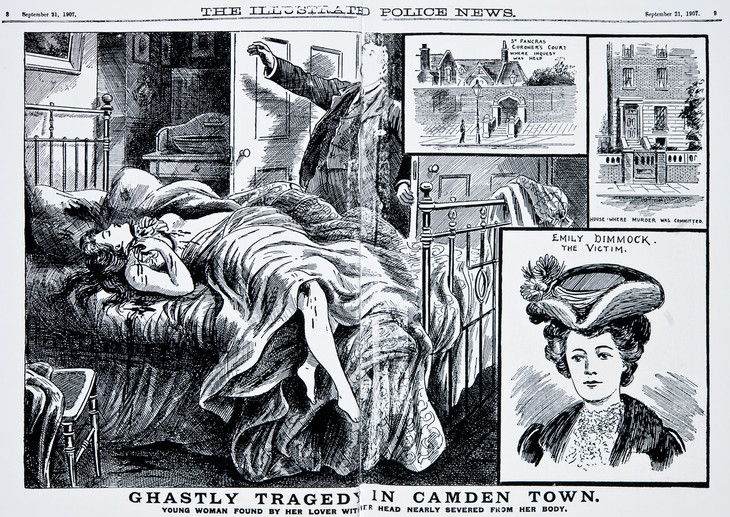
Ghastly Tragedy in Camden Town 21 September 1907 Illustrated Police News
British Newspaper Library, Colindale, London
Photo © British Newspaper Library, Colindale, London
Ghastly Tragedy in Camden Town 21 September 1907 Illustrated Police News
British Newspaper Library, Colindale, London
Photo © British Newspaper Library, Colindale, London
Maxwell Gordon Lightfoot enrols at the Slade School of Fine Art. His contemporaries include C.R.W. Nevinson and Edward Wadsworth.
1908
Harold Gilman exhibits at the Salon des Indépendants, Paris in March.
The Allied Artists’ Association is founded by the art critic Frank Rutter along the lines of the French Salon des Indépendants. Held in July at the Royal Albert Hall, the first exhibition features work by Walter Bayes, Robert Bevan, Stanislawa de Karlowska and Charles Ginner (then resident in Paris), among others. Bayes’s work is admired by Walter Sickert, who invites him to join the Fitzroy Street Group. Bevan’s work is likewise admired by Spencer Gore and Harold Gilman and he becomes a member of the group.
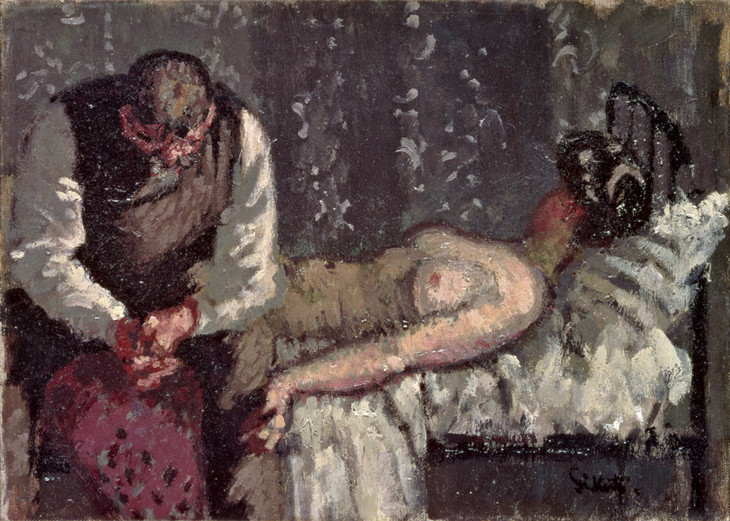
Walter Richard Sickert 1860–1942
The Camden Town Murder or What Shall We Do about the Rent? c.1908
Oil paint on canvas
256 x 356 mm
Yale Center for British Art, Paul Mellon Fund B1979.37.1
© Estate of Walter R. Sickert / DACS
Walter Richard Sickert
The Camden Town Murder or What Shall We Do about the Rent? c.1908
Yale Center for British Art, Paul Mellon Fund B1979.37.1
© Estate of Walter R. Sickert / DACS
Gilman and family move to 15 Westholm Green, Letchworth, where he befriends William Ratcliffe at number 10 and encourages the latter’s painting and association with Fitzroy Street.
James Bolivar Manson and family move to 98 Hampstead Way, Hampstead Garden Suburb.
1909
The New English Art Club gives the Fitzroy Street Group greater prominence in its exhibition programme.
Spencer Gore moves to 31 Mornington Crescent, Camden Town.
In April Charles Ginner travels to and exhibits in Buenos Aires, Argentina. At the end of the year he relocates to London from Paris, living with his mother near Battersea Park.
Walter Sickert exhibits two works from the Camden Town Murder series at the Salon d’Automne, Paris.
In winter Sickert and former student Madeline Knox set up an etching school at 209 Hampstead Road. Sylvia Gosse is a pupil.
1910
William Ratcliffe enrols part-time at the Slade School of Fine Art in January.
Walter Sickert and Madeline Knox move their expanding art school to 140 Hampstead Road, called ‘Rowlandson House’. Knox leaves and Sylvia Gosse takes over. Malcolm Drummond is a pupil.
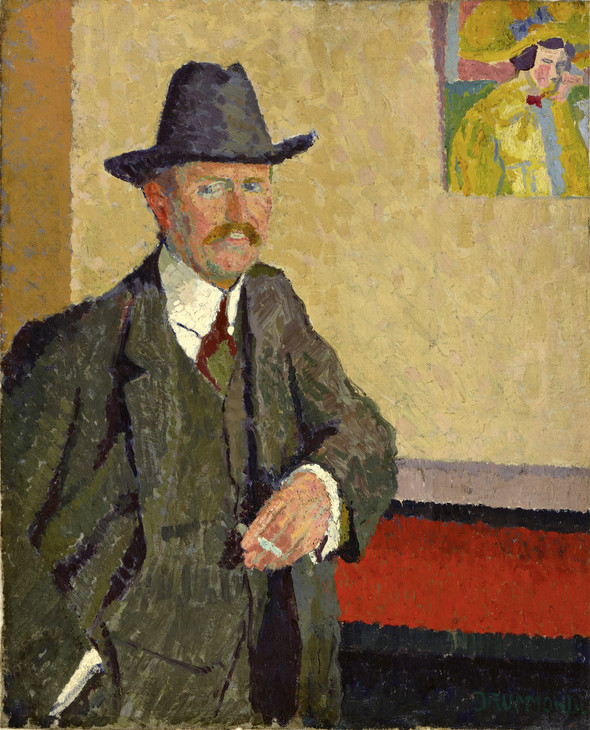
Malcolm Drummond 1880–1945
Charles Ginner 1911
Oil paint on canvas
603 x 490 mm
Southampton City Art Gallery
© Estate of Malcolm Drummond
Photo © Southampton City Art Gallery, Hampshire, UK / The Bridgeman Art Library
Malcolm Drummond
Charles Ginner 1911
Southampton City Art Gallery
© Estate of Malcolm Drummond
Photo © Southampton City Art Gallery, Hampshire, UK / The Bridgeman Art Library
Walter Sickert is appointed art critic for the periodicals the New Age and Art News.
An announcement of ‘A London Group’ appears in the New Age inviting visitors to the Fitzroy Street studio.
James Bolivar Manson and Lucien Pissarro meet and Manson is introduced to the Fitzroy Street Group.
Charles Ginner, Harold Gilman and Frank Rutter visit Paris together. They view paintings by van Gogh at Galerie Bernheim-Jeune.
Albert Rutherston holds first solo exhibition at the Carfax Gallery in October.
Roger Fry’s seminal exhibition Manet and the Post-Impressionists, including work by van Gogh, Cézanne, Gauguin, Matisse, Picasso, Derain and Vlaminck opens in London on 8 November, running to January the next year. The show has a catalytic effect on British art.
Maxwell Gordon Lightfoot participates in the winter exhibition of the New English Art Club, where his landscapes draw Gore’s attention. Gore later introduces Lightfoot to the Fitzroy Street gatherings.
1911
1911
In the spring the Camden Town Group is inaugurated after a series of discussions (some over dinner in restaurants). Sickert is responsible for the choice of the name of the group. Gore is elected president and Manson secretary. In all, there are initially sixteen members: Walter Bayes, Robert Bevan, Malcolm Drummond, Harold Gilman, Charles Ginner, Spencer Gore, James Dickson Innes, Augustus John, Henry Lamb, Wyndham Lewis, Mazwell Gordon Lightfoot, James Bolivar Manson, Lucien Pissarro, William Rartcliffe, Walter Sickert and John Doman Turner. No women are allowed to join, later a point of controversy and tension.
In March a solo exhibition of paintings by Spencer Gore opens at Chenil Gallery, Chelsea.
Ethel Sands holds her first solo exhibition in Paris.
Walter Taylor holds his first solo exhibition at the Grafton Galleries, London.
In June the first Camden Town Group exhibition is held at the Carfax Gallery, Bury Street. Maxwell Gordon Lightfoot resigns shortly afterwards and is replaced by Duncan Grant.
Walter Sickert exhibits the Camden Town Murder series at the New English Art Club.
In August Albert Rutherston, Bernard Adeney, Frederick Etchells, Duncan Grant, Macdonald (Max) Gill and Albert Rutherston begin work on a publicly commissioned decorative scheme for the Borough Polytechnic dining room in South London (now London South Bank University).
Lightfoot commits suicide on 27 September, aged twenty-five.
Douglas Fox Pitt and Walter Taylor hold a joint watercolour exhibition at the Carfax Gallery in October.
An exhibition of paintings by Paul Cézanne and Paul Gauguin opens at the Stafford Gallery, London in November, which Gore documents in the painting Gauguins and Connoisseurs at the Stafford Gallery (private collection).
In December the second Camden Town Group exhibition is held at the Carfax Gallery, including paintings by Duncan Grant.
Charles Ginner moves to 3 Chesterfield Street (now Crestfield Street) by King’s Cross Station, near to Gilman and Gore in Camden Town.
1912
In January Spencer Gore and his wife Mollie Kerr move to 2 Houghton Place, Mornington Crescent.
Nan Hudson and Ethel Sands hold a joint exhibition at the Carfax Gallery. Walter Sickert holds a solo exhibition there in May.
Madame Strindberg’s Cabaret Theatre Club on Heddon Street, off Regent Street, opens in May. Alternatively known as ‘The Cave of the Golden Calf’, the interior of the avant-garde nightclub is decorated with abstract compositions by Jacob Epstein, Eric Gill, Charles Ginner, Gore and Wyndham Lewis.
In late summer, Gore, Ginner and Robert Bevan paint at Applehayes Farm in Devon.
Gore paints in Letchworth in autumn, staying in Gilman’s house at 100 Wilbury Road while Gilman is away painting in Sweden.
William Ratcliffe stays with his brother at 127 Willifield Way, Hampstead Garden Suburb. He also travels to Sweden.
Roger Fry’s Second Post-Impressionist Exhibition of English, French and Russian Artists opens at the Grafton Galleries, London in October. Paintings by Gore, Duncan Grant, Henry Lamb and Wyndham Lewis are selected for the English section by Clive Bell.
The third and final Camden Town Group exhibition is held at the Carfax Gallery in December.
Encouraged by director Charles Aitken, James Bolivar Manson begins employment as an assistant at the Tate Gallery in December.
1913
In January Harold Gilman and Spencer Gore hold a joint exhibition at the Carfax Gallery.
The Armory Show opens in New York City in February, displaying the works of artists who are to become some of the most influential painters of the early twentieth century. The exhibition includes pictures by Walter Sickert.
Robert Bevan holds a solo exhibition at the Carfax Gallery, as does Lucien Pissarro in May.
Charles Ginner and Gilman visit Frank Rutter in Leeds for the first time, where he is employed at Leeds Art Gallery. Ginner will later paint a series of pictures of the industrial cities of Yorkshire.
Ginner and Gilman exhibit at the Allied Artists’ Association July as ‘Neo-Realists’ for the first time.
Frank Rutter’s Post-Impressionists and Futurists exhibition opens at the Doré Galleries, London in October. It includes work by Robert Bevan, Gilman, Ginner and Gore.
The London Group forms in November. Nan (Anna Hope) Hudson and Ethel Sands are among the founder members.
Marking a transitional stage between the Camden Town Group and the London Group, the Exhibition of the Work of English Post-Impressionists, Cubists and Others opens at Brighton Art Gallery in December, organised by Gore. It includes work by Walter Taylor and Douglas Fox Pitt, both Brighton residents, and anticipates the fractious emergence of vorticism.
1914
Charles Ginner publishes a manifesto on ‘Neo-Realism’ in the January New Age. The critic T.E. Hulme replies in defence of abstraction.
The first exhibition of the London Group takes place in March at the Goupil Gallery, London. Lucien Pissarro and Walter Sickert resign before the exhibition and James Bolivar Manson shortly afterwards, in response to works by Jacob Epstein and Wyndham Lewis.
Spencer Gore dies from pneumonia on 27 March.
Ginner and Harold Gilman hold a joint exhibition at the Goupil Gallery in April. The catalogue preface is titled ‘Neo-Realism’.
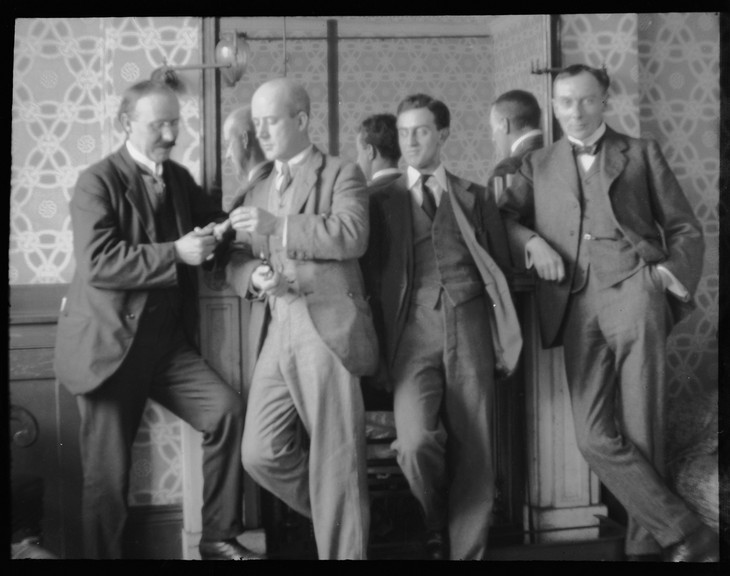
Alvin Langdon Coburn 1882–1966
The Cumberland Market Group c.1915 from left to right: Charles Ginner, Harold Gilman, John Nash and Robert Bevan
Negative, gelatine on nitrocellulose roll film
90 x 120 mm
Courtesy of George Eastman House, International Museum of Photography and Film
© Estate of Alvin Langdon Coburn
Alvin Langdon Coburn
The Cumberland Market Group c.1915 from left to right: Charles Ginner, Harold Gilman, John Nash and Robert Bevan
Courtesy of George Eastman House, International Museum of Photography and Film
© Estate of Alvin Langdon Coburn
The Whitechapel Gallery exhibition Twentieth-Century Art: A Review of Modern Movements opens in May. It traces the progress of art since the ‘absorption of Impressionism’ and includes work by Lewis and Lucien Pissarro.
Sickert calls Ginner and Gilman ‘The Thickest Painters in London’, in an article published by the New Age in June. Sickert and Gosse’s school at Rowlandson House closes the same month.
Pissarro and Manson exhibit together at the Carfax Gallery in June. They will later establish the neo-impressionist splinter faction, the Monarro Group, in 1919.
Wyndham Lewis establishes The Rebel Arts Centre at 38 Great Ormond Street. The first copies of the vorticist journal Blast (edited by Lewis) appear in London. It runs to two editions.
1915
Walter Sickert declares himself a military painter and shows work in the War Relief exhibition at the Royal Academy in January. He returns to the Westminster School of Art to teach, displacing Harold Gilman, and writes for the Burlington Magazine.
Nan Hudson and Ethel Sands set up a hospital for wounded soldiers in Normandy.
Possibly this was as early as 1914, although Wendy Baron records Sickert writing to Sands and Hudson around the time of the RA War Relief show which is why I've clustered them together here...
The only Cumberland Market Group exhibition is held at the Goupil Gallery, London in April.
Possibly this was as early as 1914, although Wendy Baron records Sickert writing to Sands and Hudson around the time of the RA War Relief show which is why I've clustered them together here...
The only Cumberland Market Group exhibition is held at the Goupil Gallery, London in April.
1916
In January Harold Gilman and Charles Ginner open a painting school at 15–16 Little Pulteney Street, Soho. Ginner is conscripted later in the year.
A memorial exhibition, Paintings by the Late Spencer F. Gore, is held at the Carfax Gallery, London in February. The catalogue contains a preface by Walter Sickert.
Sickert rejoins the London Group in summer.
1917
Harold Gilman, Charles Ginner and Frank Rutter found the illustrated quarterly journal Art and Letters.
Ginner becomes an official war artist for the Canadian Government.
Gilman and Ginner’s Soho Painting School closes in December.
1918
Walter Bayes becomes Principal of the Westminster School of Art on Sickert’s recommendation.
1919
Harold Gilman dies of influenza in February after nursing Charles Ginner through the illness, having just completed Halifax Harbour at Sunset (National Gallery of Canada) by commission of the Canadian Government. Wyndham Lewis and Louis F. Fergusson publish Harold Gilman: An Appreciation and a memorial exhibition is held at the Leicester Galleries, London in October.
How to cite
‘Chronology’, in Helena Bonett, Ysanne Holt, Jennifer Mundy (eds.), The Camden Town Group in Context, Tate Research Publication, May 2012, https://www


